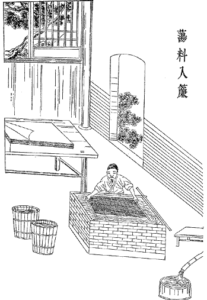Throughout history, paper has acted as a reliable, trustworthy messenger time and time again. But nowadays this trustworthy messenger is no longer the main point of contact. Digitalisation has pushed our society into a world where we rely heavily on digital advances to communicate.
But before we almost forget paper’s importance, let’s look at the significant role it’s played up until now.
A Brief History of Paper
So, let’s go way back to the first ever paper-like material, papyrus, a material made from the pith of the papyrus plant from the third millennium BC.
Ancient Egyptians made the material by extracting thin strips from the plant’s fibrous stem, arranging them in overlapping layers, dampening them, pressing them together, and allowing them to dry. Egyptians used the thin material, which paper is named after, as the chief writing material of the time.

Inscribed papyrus paper/ Credit: Public Domain
For centuries people relied on papyrus and many other materials to carry messages such as silk, cloth, reeds and skins. This remained the same until about 2,000 years ago in 105 AD, when a man called Cai Lun made the first true cellulose fibre paper from the bark of a mulberry tree in China.
The Chinese court official Cai boiled mulberry bark, hemp, old rags and fishnets to a pulp and beat the mixture before adding a large amount of water. Cai scooped the pulp onto a screen of fine bamboo slivers and pressed out the excess liquid. This resulted in a thin paper mat which was hung to dry out in the sun.

The ancient Chinese papermaking process as outlined by Cai Lun in 105 AD. Image credit: Public Domain
Before Cai’s paper invention, the Chinese wrote on bamboo and other materials such as silk and cloth, which were deemed too expensive for widespread use. Cai’s invention provided a cheaper writing material that could be manufactured on a large scale.
Cai’s discovery was reported to the emperor, who granted Cai Lun great fame and wealth. However, despite his great achievement, Cai Lun was later involved in political conflicts and committed suicide because of this.
The technique was improved over time and began to travel overseas in the 8th century along the ancient Silk Road. It wasn’t until the 11th century that paper finally arrived in Europe as a result of the Arab conquest of Sicily and Spain.
According to Frogmore Paper Mill, “As early as the thirteenth century, there were established paper mills in Spain and Italy, and in France by about 1340”. However, paper mills did not appear in England until the late 15th century. Before this, paper was imported from Europe.
The demand to produce paper on an industrial scale came about in and around the 19th century. This was characterised by the newfound interest in newspapers and best-selling novels.
In 1798, Frenchman Louis Nicolas Robert created the first machine that would replace the traditional “labour-intensive process” of making paper by hand. The machine was named the Fourdrinier, and it was able to produce “a 60-cm-long” sheet.

A model of the original paper-making machined invented by Louis Robert. Image credit: Chris55, Wikimedia
As the demand for the mass production of paper grew, alternative materials were sought out to replace papermaking rags. Wood pulp was soon discovered which decreased the price of paper dramatically. “In Britain alone, paper output soared from 96,000 tonnes a year in 1861 to 648,000 tonnes in 1900,” according to Sarah Cantavalle.
Despite digital changes, paper still continues to play a key role in society. To most, it may come as a shock that the UK paper industry generates around 12 billion pounds in revenue each year.
However, the role of paper in society has begun to change slightly. Now, the versatile material is not only used in communication, but also in cleaning, insulating, decorating, and of course, packaging.





